SOIL HEALTH AND SOIL QUALITY A REVIEW
- 格式:pdf
- 大小:110.24 KB
- 文档页数:16
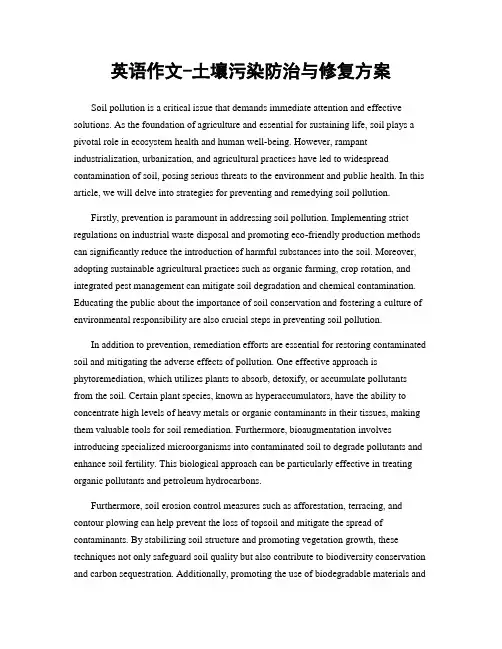
英语作文-土壤污染防治与修复方案Soil pollution is a critical issue that demands immediate attention and effective solutions. As the foundation of agriculture and essential for sustaining life, soil plays a pivotal role in ecosystem health and human well-being. However, rampant industrialization, urbanization, and agricultural practices have led to widespread contamination of soil, posing serious threats to the environment and public health. In this article, we will delve into strategies for preventing and remedying soil pollution.Firstly, prevention is paramount in addressing soil pollution. Implementing strict regulations on industrial waste disposal and promoting eco-friendly production methods can significantly reduce the introduction of harmful substances into the soil. Moreover, adopting sustainable agricultural practices such as organic farming, crop rotation, and integrated pest management can mitigate soil degradation and chemical contamination. Educating the public about the importance of soil conservation and fostering a culture of environmental responsibility are also crucial steps in preventing soil pollution.In addition to prevention, remediation efforts are essential for restoring contaminated soil and mitigating the adverse effects of pollution. One effective approach is phytoremediation, which utilizes plants to absorb, detoxify, or accumulate pollutants from the soil. Certain plant species, known as hyperaccumulators, have the ability to concentrate high levels of heavy metals or organic contaminants in their tissues, making them valuable tools for soil remediation. Furthermore, bioaugmentation involves introducing specialized microorganisms into contaminated soil to degrade pollutants and enhance soil fertility. This biological approach can be particularly effective in treating organic pollutants and petroleum hydrocarbons.Furthermore, soil erosion control measures such as afforestation, terracing, and contour plowing can help prevent the loss of topsoil and mitigate the spread of contaminants. By stabilizing soil structure and promoting vegetation growth, these techniques not only safeguard soil quality but also contribute to biodiversity conservation and carbon sequestration. Additionally, promoting the use of biodegradable materials andsustainable land management practices can reduce the accumulation of non-biodegradable waste in soil and minimize pollution risks.Moreover, fostering international cooperation and knowledge sharing is crucial in addressing the global challenge of soil pollution. By exchanging best practices, research findings, and technological innovations, countries can collaborate to develop effective strategies for soil protection and restoration. Furthermore, investing in research and development of advanced soil remediation technologies, such as nanoremediation and electrokinetic soil remediation, holds promise for more efficient and cost-effective solutions to soil pollution.In conclusion, soil pollution is a pressing environmental issue that requires concerted efforts from governments, industries, communities, and individuals. By prioritizing prevention, adopting sustainable practices, and implementing effective remediation strategies, we can safeguard soil quality, protect ecosystems, and ensure a sustainable future for generations to come. It is imperative that we act decisively and collectively to address soil pollution and preserve this invaluable resource for the well-being of our planet.。
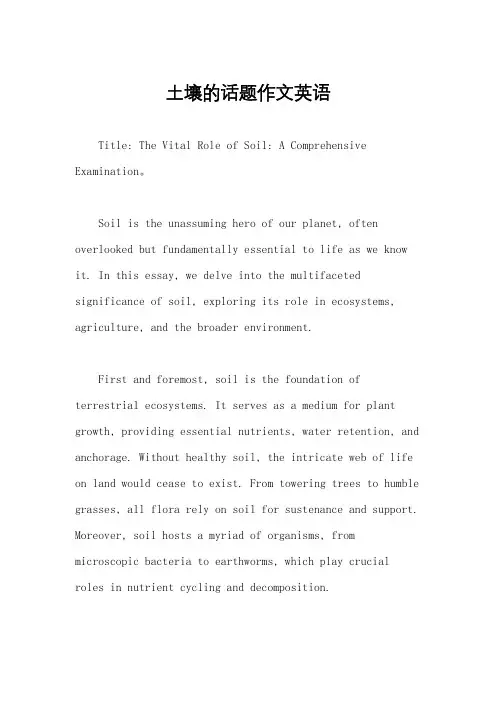
土壤的话题作文英语Title: The Vital Role of Soil: A Comprehensive Examination。
Soil is the unassuming hero of our planet, often overlooked but fundamentally essential to life as we know it. In this essay, we delve into the multifaceted significance of soil, exploring its role in ecosystems, agriculture, and the broader environment.First and foremost, soil is the foundation ofterrestrial ecosystems. It serves as a medium for plant growth, providing essential nutrients, water retention, and anchorage. Without healthy soil, the intricate web of life on land would cease to exist. From towering trees to humble grasses, all flora rely on soil for sustenance and support. Moreover, soil hosts a myriad of organisms, from microscopic bacteria to earthworms, which play crucial roles in nutrient cycling and decomposition.In agriculture, soil is the cornerstone of food production. The quality and fertility of soil directly impact crop yields and nutritional content. Farmers worldwide depend on soil health to cultivate a diverse range of crops to feed burgeoning populations. However, unsustainable agricultural practices, such as overuse of chemical fertilizers and monoculture farming, have led to soil degradation and loss of biodiversity. Addressing these challenges is imperative to ensure the long-term viability of food systems.Furthermore, soil plays a pivotal role in regulating the Earth's climate. It serves as a carbon sink, sequestering vast amounts of carbon dioxide from the atmosphere. However, deforestation, land degradation, and improper land management practices contribute to soil erosion and the release of stored carbon. This exacerbates climate change and underscores the interconnectedness of soil health and environmental stability.Beyond its ecological and agricultural significance, soil holds cultural and historical importance. Throughouthistory, civilizations have flourished or faltered based on their ability to steward the land and maintain fertile soils. Indigenous peoples around the world have developed intricate knowledge systems and sustainable land management practices rooted in respect for the soil and its ecosystems.In light of the critical role soil plays, it isessential to prioritize its conservation and restoration. Sustainable land management practices, such as conservation agriculture, agroforestry, and rotational grazing, can help mitigate soil degradation and enhance resilience to climate change. Additionally, investing in soil science researchand education is crucial for developing innovativesolutions to soil-related challenges.In conclusion, soil is a precious resource that underpins the health of our planet and sustains life in all its forms. Its significance extends far beyond mere dirt;it is a dynamic ecosystem teeming with life and essentialto the well-being of humanity. As stewards of the Earth, it is our responsibility to safeguard and nurture the soil for future generations. Only through concerted efforts toprotect and restore soil health can we ensure a sustainable and prosperous future for all.。
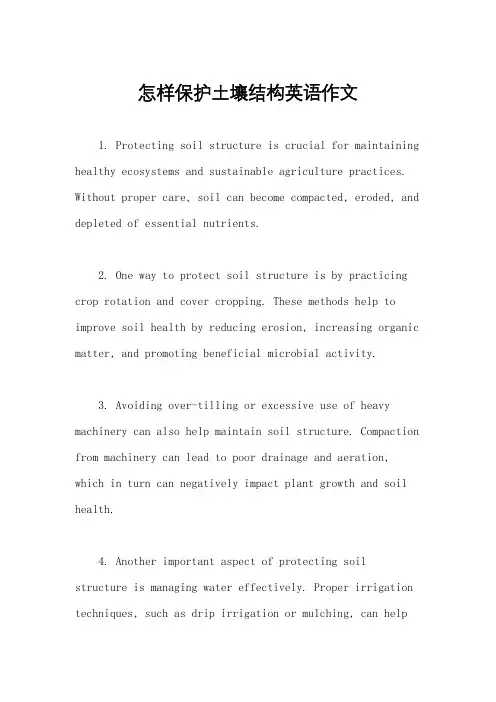
怎样保护土壤结构英语作文1. Protecting soil structure is crucial for maintaining healthy ecosystems and sustainable agriculture practices. Without proper care, soil can become compacted, eroded, and depleted of essential nutrients.2. One way to protect soil structure is by practicing crop rotation and cover cropping. These methods help to improve soil health by reducing erosion, increasing organic matter, and promoting beneficial microbial activity.3. Avoiding over-tilling or excessive use of heavy machinery can also help maintain soil structure. Compaction from machinery can lead to poor drainage and aeration, which in turn can negatively impact plant growth and soil health.4. Another important aspect of protecting soilstructure is managing water effectively. Proper irrigation techniques, such as drip irrigation or mulching, can helpprevent erosion and maintain soil moisture levels.5. Planting trees and shrubs can also help protect soil structure by providing stability and preventing erosion. Their roots help to hold soil in place and improve its structure over time.6. Finally, using organic fertilizers and avoiding chemical pesticides can help protect soil structure by promoting a healthy balance of nutrients and microbial activity in the soil. This can improve soil fertility and reduce the need for synthetic inputs that can harm soil health.。
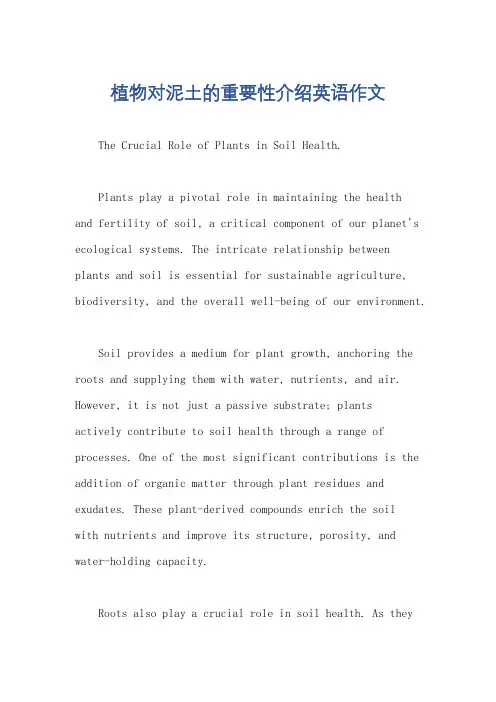
植物对泥土的重要性介绍英语作文The Crucial Role of Plants in Soil Health.Plants play a pivotal role in maintaining the healthand fertility of soil, a critical component of our planet's ecological systems. The intricate relationship betweenplants and soil is essential for sustainable agriculture, biodiversity, and the overall well-being of our environment.Soil provides a medium for plant growth, anchoring the roots and supplying them with water, nutrients, and air. However, it is not just a passive substrate; plantsactively contribute to soil health through a range of processes. One of the most significant contributions is the addition of organic matter through plant residues and exudates. These plant-derived compounds enrich the soilwith nutrients and improve its structure, porosity, and water-holding capacity.Roots also play a crucial role in soil health. As theygrow, roots create channels and pores in the soil, enhancing its aeration and water infiltration. This improved soil structure allows for better drainage and reduces the risk of erosion. Additionally, roots secrete compounds that stimulate the growth and activity of soil microorganisms, including bacteria, fungi, and protozoa. These microorganisms are vital for decomposing organic matter, releasing nutrients for plant use, and suppressing pathogenic organisms.Plants also contribute to soil health through their symbiotic relationships with certain microorganisms. For example, leguminous plants form nodules on their roots that house nitrogen-fixing bacteria. These bacteria convert atmospheric nitrogen into a form that plants can use, thus enriching the soil with this essential nutrient.Moreover, plants protect soil from erosion bystabilizing the surface and providing cover. Vegetation reduces wind and water erosion by slowing down the force of wind and water and trapping sediment. This protects soil from loss and maintains its fertility.In addition to these direct benefits, plants also contribute indirectly to soil health by attracting and providing habitats for beneficial animals and insects. For instance, certain plants attract pollinators and predatory insects that help control pest populations. These animals and insects further enrich the soil by depositing organic matter and enhancing soil aeration through their activities.The importance of plants in soil health cannot be overstated. Their contributions range from direct provision of nutrients and organic matter to indirect benefits suchas erosion control and biodiversity enhancement. Tomaintain soil health and fertility, it is crucial to manage our agricultural systems in a way that preserves and enhances these plant-soil interactions. This includes practices such as crop rotation, organic farming, and conservation agriculture, which promote soil biodiversity, protect soil structure, and enhance plant-soil interactions.In conclusion, plants are essential for maintainingsoil health and fertility. Through their contributions oforganic matter, root growth, symbiotic relationships with microorganisms, and erosion control, plants play a pivotal role in soil health and sustainability. It is crucial to recognize and value these contributions as we strive to protect and enhance soil health for future generations.。
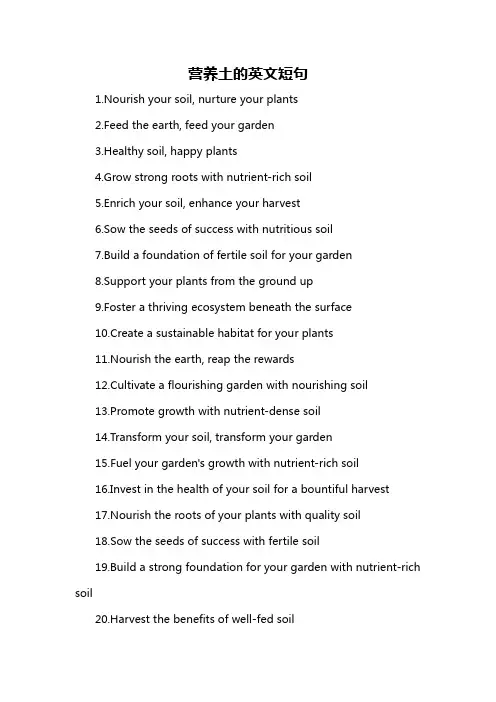
营养土的英文短句1.Nourish your soil, nurture your plants2.Feed the earth, feed your garden3.Healthy soil, happy plants4.Grow strong roots with nutrient-rich soil5.Enrich your soil, enhance your harvest6.Sow the seeds of success with nutritious soil7.Build a foundation of fertile soil for your garden8.Support your plants from the ground up9.Foster a thriving ecosystem beneath the surface10.Create a sustainable habitat for your plants11.Nourish the earth, reap the rewards12.Cultivate a flourishing garden with nourishing soil13.Promote growth with nutrient-dense soil14.Transform your soil, transform your garden15.Fuel your garden's growth with nutrient-rich soil16.Invest in the health of your soil for a bountiful harvest17.Nourish the roots of your plants with quality soil18.Sow the seeds of success with fertile soil19.Build a strong foundation for your garden with nutrient-rich soil20.Harvest the benefits of well-fed soil21.Nourish your plants with nutrient-rich soil22.Give your garden the gift of healthy soil23.Watch your plants thrive in nutrient-dense soil24.Feed your plants the best soil for growth25.Rooted in quality, our nutrient-rich soil26.Enhance your gardening experience with nutrient soil27.Discover the secret to vibrant plants: nutrient soil28.Transform your garden with nutrient-packed soil29.Nurture your plants with premium quality soil30.Unlock the potential of your plants with enriched soil31.Experience the difference with nutrient soil32.Foster healthy plant growth with nutrient-rich soil33.Give your plants the foundation they need with nutrient soil34.Elevate your gardening game with nutrient-enriched soil35.Support your plants with the best soil on the market36.Boost your plant's health with our nutrient-dense soil37.Invest in your garden's future with nutrient-rich soil38.Upgrade your gardening routine with nutrient soil39.Create a thriving garden with nutrient-packed soil40.Choose the superior option for your plants: nutrient soil41.Nourish your plants from the ground up42.Create a thriving ecosystem in your garden43.Give your plants the nutrients they need to grow strong44.Invest in the health of your soil for bountiful harvests45.Revitalize your garden with nutrient-rich soil46.Transform your soil into a powerhouse of growth47.Maximize the potential of your plants with quality soil48.Cultivate a rich and fertile environment for your garden49.Empower your plants with the nourishment they deserve50.Elevate your gardening game with nutrient-dense soil51.Boost the health and vitality of your plants with rich soil52.Unleash the potential of your garden with premium soil53.Enhance the flavor and nutrition of your produce with quality soil54.Foster a healthy and vibrant garden with the right soil55.Support the growth of your plants with nutrient-packed soil56.Nourish your soil to cultivate a flourishing garden57.Empower your plants to reach their full potential with quality soil58.Provide your garden with the foundation it needs to thrive59.Invest in the future of your garden by nourishing the soil60.Transform ordinary soil into a nutrient-rich powerhouse for your plants61.Nourish your soil, nourish your plants.62.A foundation of health starts with nutrient-rich soil.63.Healthy soil, healthy planet.64.Revitalize your soil for a thriving garden.65.Feed your soil, watch your garden flourish.66.Build a strong foundation with nutrient-dense soil.67.Invest in your soil, invest in your future harvests.68.Healthy soil is the key to a successful garden.69.Prioritize soil health for a bountiful garden.70.Give your soil the love and care it deserves.71.Start from the ground up with nutrient-dense soil.72.Elevate your gardening game with nutrient-rich soil.73.Soil health is the secret to a lush, vibrant garden.74.Nourish your soil to feed your plants naturally.75.Create a sustainable garden with nutrient-rich soil.76.Soil is the foundation of all life - treat it well.77.The quality of your soil determines the quality of your harvest.78.Boost your soil to boost your plant's growth.79.Healthy soil, happy plants.80.A nourished soil leads to a flourishing garden.81.Fertile soil, the foundation of life.82.Nourishing the earth, one soil at a time.83.Growing together with nutrient-rich soil.84.Fueling growth with organic soil.85.In the heart of every plant lies the essence of fertile soil.86.Agricultural abundance starts with nutrient-dense soil.87.The roots of healthy crops run deep in fertile soil.88.Cultivating a future filled with nutrient-rich soil.89.From soil to table, the journey of nourishment begins.90.Sowing the seeds of sustainability with fertile soil.91.Harvesting the benefits of nutrient-rich soil.92.The secret ingredient to a successful harvest? Fertile soil.93.Cultivating the land, cultivating the future.94.Nurturing soil health for generations to come.95.Bearing the fruits of fertile soil.96.The roots of life grow deep in rich soil.97.Sustainable agriculture starts with nutrient-dense soil.98.From the ground up, nourishing our planet with fertile soil.99.Growing stronger roots in healthier soil.100.The cycle of life begins in the nutrient-rich soil.101.Provide essential nutrients for plants to thrive102.Enhance soil structure and improve water retention 103.Optimize root growth and boost plant health104.Increase nutrient uptake and utilization105.Support beneficial microorganisms in the soil106.Promote strong and vigorous plant growth107.Reduce the risk of nutrient deficiencies108.Create a fertile environment for plants to flourish109.Improve soil fertility and overall plant performance 110.Nourish plants from the ground up111.Achieve better yields and higher quality crops112.Maintain balanced soil pH levels113.Minimize nutrient leaching and runoff114.Restore depleted soils and rejuvenate land115.Create sustainable and eco-friendly farming practices 116.Support a healthy and thriving ecosystem117.Improve soil biodiversity and resilience118.Contribute to a greener and more sustainable environment 119.Enhance crop resilience to environmental stresses120.Boost plant immunity and disease resistance121.Healthy soil leads to healthy crops.122.Nourish the soil, nourish the world.123.The foundation of agriculture is fertile soil.124.Invest in your soil for a fruitful harvest.125.Protect the soil, protect our future.126.The key to sustainable farming lies in the soil.127.Healthy soil promotes biodiversity.128.Revitalize your soil for greater yields.129.Soil is the lifeline of agriculture.130.Enhance your soil, enhance your crops.131.Healthy soil is the backbone of food security.132.Feed the soil, feed the planet.133.Be a steward of the soil for future generations.134.Diverse soil microbiology leads to robust crops.135.Soil health is the cornerstone of sustainable farming.136.Fertile soil is a farmer's best asset.137.A healthy soil ecosystem is a resilient one.138.Healthy soil leads to a healthy environment.139.Nourish the soil, nurture life.140.The quality of your soil determines the quality of your harvest.141.Nourish your plants with the power of nutrient-rich soil 142.Give your garden the gift of healthy and fertile soil143.Watch your plants thrive in nutrient-dense soil144.Transform your garden with the magic of nourishing soil 145.Enhance the growth and vitality of your plants with nutrient-rich soil146.Create a flourishing garden with the help ofnutrient-packed soil147.Provide your plants with the essential nutrients they need to thrive148.Experience the difference of using high-quality,nutrient-rich soil149.Give your plants a strong foundation with nutrient-dense soil150.See the amazing results of using nutrient-rich soil in your garden151.Nurture your plants with soil that is full of essential nutrients152.Create a healthy ecosystem in your garden with nutrient-rich soil153.Give your plants the best start in life with nutrient-packed soil154.Ensure your plants have access to all the nutrients they need to grow155.Invest in the health and growth of your plants with nutrient-rich soil156.Experience the joy of gardening with nutrient-dense soil 157.Unlock the full potential of your plants with the help of nutrient-rich soil158.Provide your garden with the nutrients it needs to thrive 159.Give your plants a competitive edge with nutrient-packed soil160.Celebrate the beauty of a garden nourished bynutrient-rich soil。
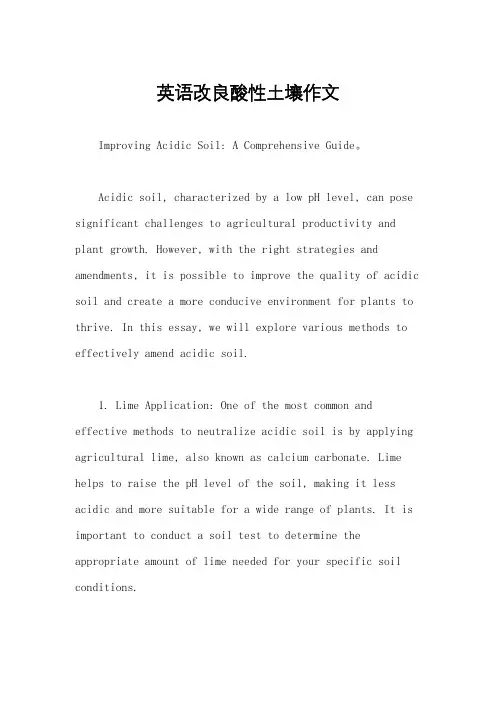
英语改良酸性土壤作文Improving Acidic Soil: A Comprehensive Guide。
Acidic soil, characterized by a low pH level, can pose significant challenges to agricultural productivity and plant growth. However, with the right strategies and amendments, it is possible to improve the quality of acidic soil and create a more conducive environment for plants to thrive. In this essay, we will explore various methods to effectively amend acidic soil.1. Lime Application: One of the most common and effective methods to neutralize acidic soil is by applying agricultural lime, also known as calcium carbonate. Lime helps to raise the pH level of the soil, making it less acidic and more suitable for a wide range of plants. It is important to conduct a soil test to determine the appropriate amount of lime needed for your specific soil conditions.2. Organic Matter Addition: Incorporating organicmatter such as compost, manure, or cover crops into acidic soil can help improve its fertility and structure. Organic matter acts as a buffer, helping to stabilize pH levels and providing essential nutrients to plants. Regular additionsof organic matter can gradually improve soil quality over time.3. Mulching: Mulching the soil surface with organic materials like straw, leaves, or wood chips can help maintain moisture levels and regulate soil temperature. Additionally, organic mulches break down over time,enriching the soil with nutrients and improving its overall health.4. Avoiding Acidifying Fertilizers: Certain fertilizers, such as ammonium-based fertilizers, can contribute to soil acidity over time. It is important to choose fertilizersthat are less likely to acidify the soil, such as those containing calcium or magnesium. Balancing nutrient inputsis crucial for maintaining optimal soil pH levels.5. Crop Rotation: Implementing a diverse crop rotation system can help prevent the buildup of acidity in the soil. Different crops have varying nutrient requirements and effects on soil pH. By rotating crops, you can balance nutrient uptake and minimize soil acidification.6. pH Monitoring and Maintenance: Regular monitoring of soil pH levels is essential for ensuring the effectiveness of soil improvement efforts. pH testing kits are readily available and can provide valuable information for adjusting lime or fertilizer applications as needed.7. Soil Amendments: In addition to lime, other soil amendments such as gypsum or elemental sulfur can be used to modify soil pH levels. These amendments should be applied according to soil test recommendations and in conjunction with other soil improvement practices.8. Water Management: Proper water management iscritical for maintaining soil pH balance. Excessiverainfall or irrigation can leach nutrients and increasesoil acidity, while drought conditions can concentrateacids in the soil. Implementing efficient irrigation practices and improving drainage can help mitigate these effects.In conclusion, improving acidic soil requires a multifaceted approach that addresses both short-term adjustments and long-term soil management practices. By incorporating lime application, organic matter addition, mulching, appropriate fertilization, crop rotation, pH monitoring, soil amendments, and water management strategies, it is possible to gradually enhance soil quality and create a more favorable environment for plant growth.。
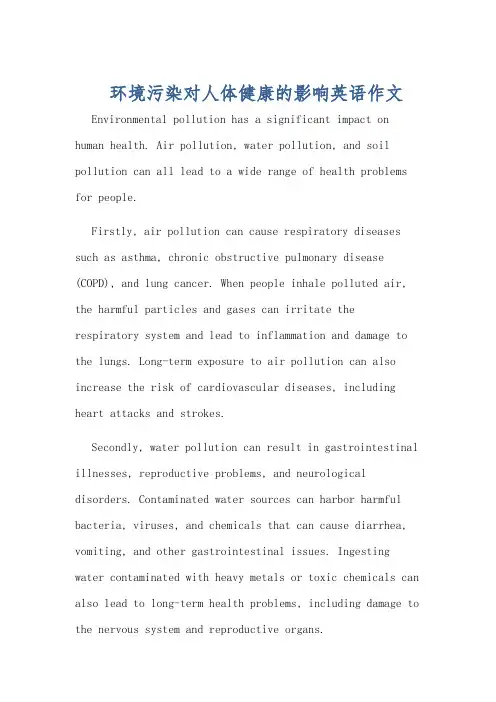
环境污染对人体健康的影响英语作文Environmental pollution has a significant impact on human health. Air pollution, water pollution, and soil pollution can all lead to a wide range of health problems for people.Firstly, air pollution can cause respiratory diseases such as asthma, chronic obstructive pulmonary disease (COPD), and lung cancer. When people inhale polluted air, the harmful particles and gases can irritate therespiratory system and lead to inflammation and damage to the lungs. Long-term exposure to air pollution can also increase the risk of cardiovascular diseases, including heart attacks and strokes.Secondly, water pollution can result in gastrointestinal illnesses, reproductive problems, and neurological disorders. Contaminated water sources can harbor harmful bacteria, viruses, and chemicals that can cause diarrhea, vomiting, and other gastrointestinal issues. Ingesting water contaminated with heavy metals or toxic chemicals can also lead to long-term health problems, including damage to the nervous system and reproductive organs.Lastly, soil pollution can impact human health through the food chain. When crops are grown in contaminated soil, they can absorb harmful substances, which can then be passed on to humans through the consumption of contaminated food. This can lead to a range of health issues, including food poisoning, organ damage, and an increased risk of cancer.In conclusion, environmental pollution poses a serious threat to human health. It is imperative that we take steps to reduce pollution and protect our environment in order to safeguard the health and well-being of current and future generations.环境污染对人体健康有着显著的影响。
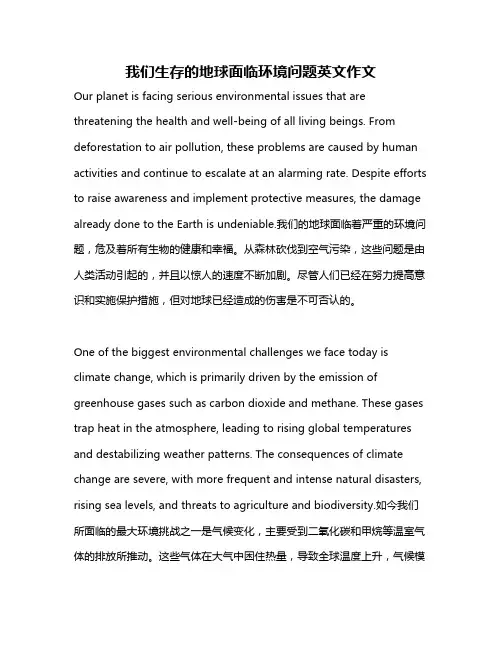
我们生存的地球面临环境问题英文作文Our planet is facing serious environmental issues that are threatening the health and well-being of all living beings. From deforestation to air pollution, these problems are caused by human activities and continue to escalate at an alarming rate. Despite efforts to raise awareness and implement protective measures, the damage already done to the Earth is undeniable.我们的地球面临着严重的环境问题,危及着所有生物的健康和幸福。
从森林砍伐到空气污染,这些问题是由人类活动引起的,并且以惊人的速度不断加剧。
尽管人们已经在努力提高意识和实施保护措施,但对地球已经造成的伤害是不可否认的。
One of the biggest environmental challenges we face today is climate change, which is primarily driven by the emission of greenhouse gases such as carbon dioxide and methane. These gases trap heat in the atmosphere, leading to rising global temperatures and destabilizing weather patterns. The consequences of climate change are severe, with more frequent and intense natural disasters, rising sea levels, and threats to agriculture and biodiversity.如今我们所面临的最大环境挑战之一是气候变化,主要受到二氧化碳和甲烷等温室气体的排放所推动。
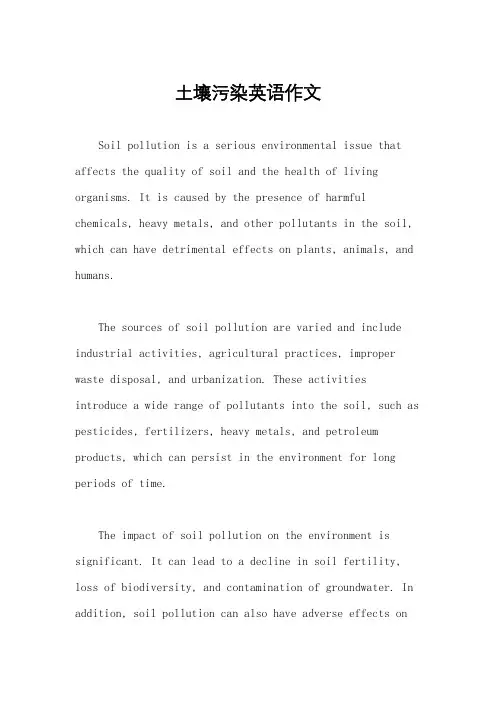
土壤污染英语作文Soil pollution is a serious environmental issue that affects the quality of soil and the health of living organisms. It is caused by the presence of harmful chemicals, heavy metals, and other pollutants in the soil, which can have detrimental effects on plants, animals, and humans.The sources of soil pollution are varied and include industrial activities, agricultural practices, improper waste disposal, and urbanization. These activities introduce a wide range of pollutants into the soil, such as pesticides, fertilizers, heavy metals, and petroleum products, which can persist in the environment for long periods of time.The impact of soil pollution on the environment is significant. It can lead to a decline in soil fertility, loss of biodiversity, and contamination of groundwater. In addition, soil pollution can also have adverse effects onhuman health, as pollutants can enter the food chain through plants and animals, leading to potential health risks for those who consume contaminated food.Preventing soil pollution requires a concerted effort from individuals, industries, and governments. This can be achieved through the implementation of sustainable agricultural practices, proper waste management, and the use of environmentally friendly products. In addition, remediation efforts, such as soil restoration and cleanup, can help to mitigate the effects of soil pollution and restore the health of the soil.Overall, soil pollution is a significant environmental problem that requires immediate attention and action. By raising awareness about the causes and consequences of soil pollution, and taking proactive measures to prevent and mitigate its effects, we can work towards a healthier and more sustainable environment for future generations.。
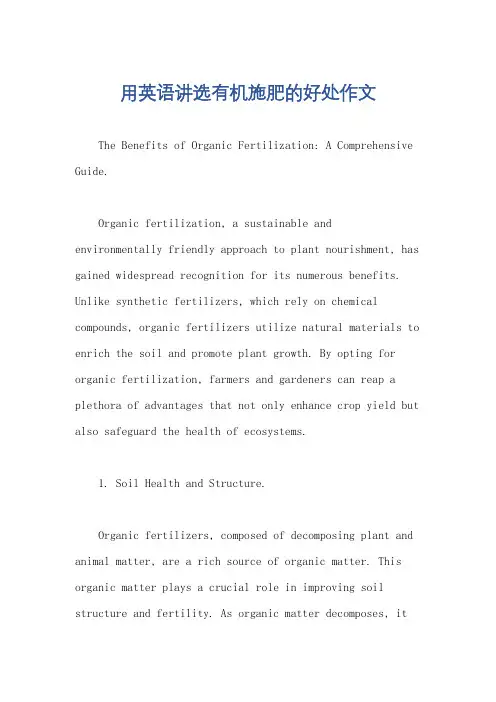
用英语讲选有机施肥的好处作文The Benefits of Organic Fertilization: A Comprehensive Guide.Organic fertilization, a sustainable and environmentally friendly approach to plant nourishment, has gained widespread recognition for its numerous benefits. Unlike synthetic fertilizers, which rely on chemical compounds, organic fertilizers utilize natural materials to enrich the soil and promote plant growth. By opting for organic fertilization, farmers and gardeners can reap a plethora of advantages that not only enhance crop yield but also safeguard the health of ecosystems.1. Soil Health and Structure.Organic fertilizers, composed of decomposing plant and animal matter, are a rich source of organic matter. This organic matter plays a crucial role in improving soil structure and fertility. As organic matter decomposes, itreleases essential nutrients such as nitrogen, phosphorus, and potassium, providing a slow and sustained source of nourishment for plants. Additionally, organic matter enhances soil aeration and water retention capacity,creating an optimal environment for root development and nutrient uptake.2. Microbial Activity.Organic fertilizers foster a thriving microbial ecosystem in the soil. Microorganisms, such as bacteria, fungi, and protozoa, break down organic matter into plant-available nutrients. These beneficial microbes also play a vital role in soil aggregation, nutrient cycling, and disease suppression. By promoting microbial activity, organic fertilization supports a balanced and resilientsoil ecosystem, which is essential for healthy plant growth.3. Nutrient Availability.Unlike synthetic fertilizers, organic fertilizers provide a balanced release of nutrients over an extendedperiod. This slow and steady delivery ensures that plants have access to the nutrients they need throughout their growth cycle. Organic fertilizers also improve nutrient uptake efficiency by increasing soil organic matter content, which acts as a buffer against nutrient leaching and loss.4. Reduced Chemical Dependency.Organic fertilization practices eliminate the reliance on synthetic chemical fertilizers, which can havedetrimental effects on the environment and human health. Synthetic fertilizers often contain high levels of soluble salts, which can accumulate in the soil and lead to soil salinity. Additionally, excessive use of syntheticfertilizers can contribute to water pollution and eutrophication. By adopting organic fertilization, farmers and gardeners can minimize their dependence on harmful chemicals, protecting ecosystems and promoting asustainable future.5. Enhanced Crop Quality.Studies have shown that crops fertilized with organic matter exhibit improved quality characteristics. Fruits and vegetables grown with organic fertilizers tend to have higher levels of vitamins, minerals, and antioxidants. The presence of beneficial microorganisms in organically fertilized soils also contributes to increased disease resistance and reduced pest infestations, resulting in healthier and more nutritious produce.6. Environmental Sustainability.Organic fertilization practices are inherently sustainable and environmentally friendly. By utilizing renewable and biodegradable materials, organic fertilizers avoid the use of non-renewable resources and reduce greenhouse gas emissions associated with the production and transportation of synthetic fertilizers. Additionally, organic fertilization promotes biodiversity, protects water quality, and mitigates soil erosion, contributing to a healthier and more sustainable planet.7. Economic Benefits.While organic fertilizers may initially require a higher investment than synthetic fertilizers, they canoffer long-term economic benefits. Organic fertilization practices improve soil health and fertility over time, reducing the need for additional inputs and enhancing crop productivity. Additionally, organic farming systems often fetch premium prices in the marketplace, as consumers increasingly seek out sustainably produced food.Conclusion.Organic fertilization offers a multitude of benefits that far outweigh its perceived drawbacks. By embracing organic practices, farmers and gardeners can enhance soil health, promote microbial activity, improve nutrient availability, reduce chemical dependency, enhance crop quality, protect the environment, and achieve economic sustainability. As the world faces increasing challenges related to food security and environmental degradation, organic fertilization stands as a beacon of hope for a more sustainable and resilient future.。
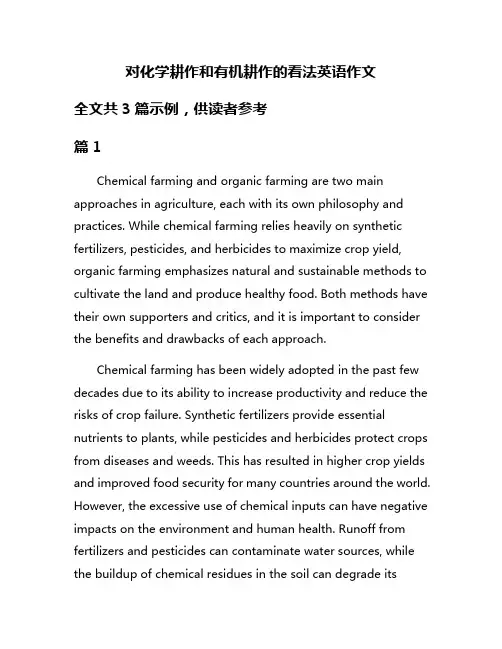
对化学耕作和有机耕作的看法英语作文全文共3篇示例,供读者参考篇1Chemical farming and organic farming are two main approaches in agriculture, each with its own philosophy and practices. While chemical farming relies heavily on synthetic fertilizers, pesticides, and herbicides to maximize crop yield, organic farming emphasizes natural and sustainable methods to cultivate the land and produce healthy food. Both methods have their own supporters and critics, and it is important to consider the benefits and drawbacks of each approach.Chemical farming has been widely adopted in the past few decades due to its ability to increase productivity and reduce the risks of crop failure. Synthetic fertilizers provide essential nutrients to plants, while pesticides and herbicides protect crops from diseases and weeds. This has resulted in higher crop yields and improved food security for many countries around the world. However, the excessive use of chemical inputs can have negative impacts on the environment and human health. Runoff from fertilizers and pesticides can contaminate water sources, while the buildup of chemical residues in the soil can degrade itsquality over time. In addition, the use of chemical pesticides has led to the development of pesticide-resistant pests, posing a threat to crop yields and food security in the long term.On the other hand, organic farming focuses on maintaining soil health and biodiversity through natural practices such as crop rotation, composting, and biological pest control. Organic farmers avoid synthetic inputs and rely on natural sources of nutrients to feed the soil and nourish the crops. This results in healthier soil, which in turn produces healthier plants that are more resilient to pests and diseases. Organic farming also promotes biodiversity by providing habitat for beneficial insects and wildlife, leading to a more balanced ecosystem. Furthermore, organic farming practices have been shown to reduce the carbon footprint of agriculture by sequestering carbon in the soil and reducing greenhouse gas emissions.While organic farming offers many benefits for the environment and human health, it also faces challenges such as lower yields and higher labor costs compared to chemical farming. Organic farmers may struggle to compete in the market against conventional farmers who can produce more at a lower cost. In addition, the certification process for organic products can be cumbersome and expensive for small-scale farmers,limiting their access to the growing organic market. However, as consumer awareness of the environmental and health benefits of organic food continues to grow, the demand for organic products is increasing, creating opportunities for organic farmers to thrive.In conclusion, both chemical farming and organic farming have their own advantages and disadvantages. While chemical farming has been successful in increasing crop yields and ensuring food security, it also poses risks to the environment and human health. Organic farming, on the other hand, offers a sustainable and environmentally-friendly alternative to conventional agriculture, but it requires more resources and may not be as productive in the short term. Ultimately, the choice between chemical farming and organic farming depends on the goals and values of farmers and consumers. By supporting sustainable agricultural practices and promoting organic products, we can create a more resilient and healthy food system for future generations.篇2Chemical farming and organic farming are two different approaches to agriculture that have been a topic of debate for many years. While chemical farming relies on synthetic fertilizers,pesticides, and herbicides to boost crop yields, organic farming focuses on natural and sustainable methods to cultivate the land. Here, we will explore the pros and cons of both chemical and organic farming to better understand their impact on the environment and human health.Chemical farming, also known as conventional farming, has been the dominant method of agriculture for many decades. It has allowed farmers to increase crop yields and meet the growing demand for food worldwide. By using synthetic fertilizers, pesticides, and herbicides, chemical farmers can control pests and weeds more effectively, leading to higher productivity. However, the use of these chemicals has raised concerns about their long-term impact on the environment and human health.One of the biggest issues with chemical farming is its reliance on synthetic fertilizers, which can deplete the soil of essential nutrients over time. This can lead to soil erosion, loss of biodiversity, and water pollution as chemicals wash into rivers and lakes. Additionally, the use of pesticides and herbicides in chemical farming has been linked to various health problems in humans, such as cancer, reproductive issues, and respiratoryproblems. These chemicals can also harm beneficial insects and wildlife, disrupting the delicate balance of ecosystems.On the other hand, organic farming offers a more sustainable and environmentally friendly approach to agriculture. By avoiding synthetic chemicals and focusing on natural methods, organic farmers can improve soil health, conserve water, and protect biodiversity. Organic farming also promotes the use of crop rotation, cover crops, and composting to maintain soil fertility and reduce the risk of pests and diseases. In addition, organic farming has been shown to produce crops with higher levels of antioxidants and nutrients, making them healthier for consumers.Despite its many benefits, organic farming also has its challenges. Organic farmers may struggle to compete with conventional farmers in terms of crop yields and profitability, especially in the short term. Organic farming also requires more labor and resources to manage pests and weeds without the use of synthetic chemicals. In addition, the certification process for organic farming can be expensive and time-consuming, limiting access to this method for some farmers.In conclusion, both chemical farming and organic farming have their pros and cons, and the choice between the twoultimately depends on the priorities of the farmer and society as a whole. While chemical farming has helped to feed a growing population and increase crop yields, it comes with significant environmental and health risks. Organic farming, on the other hand, offers a more sustainable and natural approach to agriculture, but it may require more time, effort, and resources to implement successfully.As consumers, we can support sustainable agriculture by choosing organic products whenever possible and advocating for policies that promote environmentally friendly farming practices. By supporting farmers who prioritize soil health, biodiversity, and human health, we can help to create a more sustainable and resilient food system for future generations.篇3Chemical Farming vs. Organic Farming: A Comparative AnalysisIntroductionAgriculture is the backbone of any country's economy. It is essential for providing food, clothing, shelter, and fuel. The two main methods of farming that have gained popularity over the years are chemical farming and organic farming. Chemicalfarming involves the use of synthetic chemicals such as pesticides, fertilizers, and herbicides, whereas organic farming focuses on using natural methods such as crop rotation, composting, and natural pest control.In this essay, we will discuss the pros and cons of chemical farming and organic farming and compare the two methods to determine which is more sustainable and environmentally friendly.Chemical FarmingChemical farming has revolutionized agriculture by increasing crop yields and reducing labor costs. The use of synthetic chemicals such as fertilizers has enabled farmers to produce more food on less land. Pesticides and herbicides have also helped to control pests and weeds, which would otherwise damage crops and reduce yields.However, the use of synthetic chemicals in agriculture has raised concerns about environmental pollution and human health. The overuse of pesticides and herbicides can lead to water pollution, soil erosion, and loss of biodiversity. In addition, the chemicals used in farming can contaminate food and water sources, posing a risk to human health.Organic FarmingOrganic farming, on the other hand, is a more sustainable and environmentally friendly method of farming. Organic farmers rely on natural methods such as composting, crop rotation, and natural pest control to grow crops. This helps to maintain soil health, preserve biodiversity, and protect water sources from pollution.Organic farming also promotes healthy eating habits by producing food that is free from synthetic chemicals and GMOs. Organic food is known to be more nutritious and flavorful than conventionally grown food, making it a popular choice among consumers.ComparisonWhen comparing chemical farming and organic farming, it is clear that organic farming is the more sustainable and environmentally friendly option. Organic farming promotes soil health, biodiversity, and water conservation, while chemical farming leads to soil degradation, water pollution, and loss of biodiversity.Furthermore, organic farming is better for human health as it produces food that is free from synthetic chemicals and GMOs.Organic food is also known to be more nutritious and flavorful than conventionally grown food, making it a healthier choice for consumers.ConclusionIn conclusion, organic farming is a more sustainable and environmentally friendly method of farming compared to chemical farming. Organic farming promotes soil health, biodiversity, and water conservation, while chemical farming leads to soil degradation, water pollution, and loss of biodiversity.Therefore, it is important for farmers to adopt organic farming practices to protect the environment, preserve biodiversity, and promote healthy eating habits. By choosing organic farming over chemical farming, we can ensure a sustainable future for agriculture and a healthier planet for future generations.。
有机耕作和化学耕作的利弊英语作文全文共10篇示例,供读者参考篇1Organic farming and chemical farming are two different ways to grow food. Organic farming uses natural methods to help plants grow, like compost and manure. Chemical farming uses artificial chemicals like pesticides and fertilizers.Organic farming has many benefits. It's better for the environment because it doesn't use harmful chemicals. It also helps to keep the soil healthy and full of nutrients. Organic food is also better for us because it has fewer chemicals in it. Some people say that organic food tastes better too!But there are some downsides to organic farming. It can be more expensive to buy organic food because it takes more time and effort to grow. Organic farms also tend to produce less food than chemical farms. This means that organic food can be harder to find and more expensive to buy.Chemical farming also has its benefits. It can produce more food at a faster rate, which helps to feed more people. Chemicalfarming is also easier and cheaper for farmers to do. They can use machines and chemicals to help their crops grow quickly.But there are some drawbacks to chemical farming. The chemicals used can harm the environment and the creatures that live in it. They can also get into our food and water, which can be bad for our health. Some people also say that chemical food doesn't taste as good as organic food.In conclusion, both organic farming and chemical farming have their pros and cons. It's up to us to decide which way we want to grow our food. Whether we choose organic or chemical farming, it's important to think about the impact it has on the environment and our health. Let's make the best choice for our planet and ourselves!篇2Organic farming and chemical farming are two different ways to grow crops. Let's talk about the advantages and disadvantages of each method!Organic farming is all about using natural methods to grow crops. Farmers use things like compost and manure to fertilize the soil instead of chemical fertilizers. This helps to keep the soil healthy and full of nutrients. Organic farmers also don't usechemical pesticides to control pests. Instead, they rely on things like beneficial insects and crop rotation to keep pests away. This helps to protect the environment and keep our food safe to eat.However, there are also some disadvantages to organic farming. Since organic farmers don't use chemical fertilizers or pesticides, their crops may not be as big or as plentiful as those grown using chemicals. This can lead to higher prices for organic produce. Organic farming also requires more labor and time, which can make it more expensive for farmers.On the other hand, chemical farming relies on synthetic fertilizers and pesticides to grow crops quickly and in large quantities. This can be more efficient and cost-effective for farmers. Chemical farming can also help to control pests and diseases more easily, leading to higher crop yields.But there are also drawbacks to chemical farming. The use of chemical fertilizers and pesticides can harm the environment by polluting water sources and killing beneficial insects. There are also concerns about the long-term effects of chemicals on human health.In conclusion, both organic farming and chemical farming have their pros and cons. Organic farming is better for the environment and our health, but it can be more expensive andlabor-intensive. Chemical farming may be more efficient and cost-effective, but it can harm the environment and our health in the long run. It's important for farmers and consumers to weigh the benefits and drawbacks of each method and make informed choices about how our food is grown.篇3Organic farming and chemical farming are two different ways to grow plants. Let's talk about the advantages and disadvantages of each!Organic farming is like natural farming. We use natural things like compost and manure to help plants grow. It's good because we don't use harmful chemicals that can hurt the environment. Also, it makes our food healthier because there are no chemicals in it. But organic farming can be hard work and sometimes we don't get as much food as we do with chemical farming.Chemical farming uses things like pesticides and fertilizers to help plants grow. It's faster and easier than organic farming, and we can get more food from it. However, the chemicals can hurt the environment and make our food less healthy. Also, somepests and weeds become resistant to the chemicals over time, so we have to use more and more of them.In my opinion, organic farming is better because it's better for the environment and for our health. But we can also learn from chemical farming and find ways to make organic farming more efficient. It's important to find a balance between the two so we can grow healthy food and protect the planet.That's all for now! Thanks for listening!篇4Organic farming and chemical farming are two ways people grow their food. They both have advantages and disadvantages.First, let's talk about organic farming. Organic farming is when farmers use natural ways to grow their crops, like compost and manure. This is good because it doesn't pollute the environment and it keeps the soil healthy. Organic food is also better for our bodies because it doesn't have any harmful chemicals in it. However, organic farming can be more expensive and it may not produce as much food as chemical farming.Now, let's talk about chemical farming. Chemical farming is when farmers use fertilizers and pesticides to grow their crops.This can make the crops grow faster and bigger, which is good for feeding more people. Chemical farming is also cheaper than organic farming. However, the chemicals used in chemical farming can be harmful to the environment and our health. They can pollute the water and soil, and they can even make us sick if we eat too much of them.In conclusion, both organic farming and chemical farming have their own benefits and drawbacks. Organic farming is better for the environment and our health, but it can be more expensive and produce less food. Chemical farming is cheaper and produces more food, but it can harm the environment and our health. It's important for us to choose the right balance between the two to make sure we have enough food to eat without causing harm to ourselves and the planet.篇5Organic farming and chemical farming are two different ways of growing crops. Organic farming uses only natural materials, like compost and manure, to help plants grow. Chemical farming, on the other hand, uses fertilizers and pesticides made in a lab to help plants grow.There are some advantages to organic farming. First of all, it is better for the environment because it does not use chemicals that can harm the soil and water. Organic farming also does not use genetically modified organisms (GMOs), which some people believe are not healthy to eat. Additionally, organic food is often healthier because it is grown without chemicals.However, there are also some disadvantages to organic farming. It can be more expensive because organic materials are often more costly than chemical fertilizers and pesticides. Organic farming also usually produces fewer crops because it does not use chemicals to help plants grow faster. This can lead to higher prices for organic food.On the other hand, chemical farming also has its advantages. It can produce higher yields of crops because the chemicals help plants grow faster and larger. This can help feed more people and keep food prices lower. Chemical farming is also usually less expensive than organic farming because the materials used are cheaper.But there are also disadvantages to chemical farming. One big problem is that the chemicals used can harm the environment by polluting the soil and water. Pesticides can also be harmful to animals and people if they are not used carefully.Additionally, some people believe that eating food grown with chemicals is not as healthy as eating organic food.In conclusion, both organic farming and chemical farming have their pros and cons. It is important for farmers to choose the method that is best for the environment and for the health of the people who will be eating the food. We should all try to support farmers who are using sustainable and healthy methods to grow our food.篇6Organic Farming vs Chemical FarmingHey guys! Today let's talk about organic farming and chemical farming. So, what's the difference between them? Well, organic farming uses natural ways to grow crops like compost and manure, while chemical farming uses synthetic fertilizers and pesticides. Let's find out the advantages and disadvantages of each method!Organic farming is good because it's better for the environment. It doesn't use harmful chemicals that can pollute the soil and water. Also, organic food is healthier because it doesn't have any chemicals on it. But, organic farming can bemore expensive and the yield might not be as high as chemical farming.On the other hand, chemical farming can produce a lot of food in a short time. This is good because we need a lot of food to feed everyone in the world. Also, chemical farming is cheaper and more convenient. However, using too many chemicals can harm the environment and our health. Some chemicals can even stay in the food we eat!In conclusion, both organic farming and chemical farming have their pros and cons. Organic farming is better for the environment and our health, but it can be more expensive. Chemical farming can produce a lot of food quickly, but it can harm the environment. So, it's important to think about the way we grow our food and choose the best method for the future of our planet! Let's go green and eat healthy, guys!篇7Organic Farming and Chemical Farming are two ways of growing food. They both have their own good and bad points. Let's take a look at them!Organic Farming is when farmers grow food without using chemicals or pesticides. They use things like compost and naturalfertilizers to help the plants grow. This way, the food is healthier for us to eat and it is better for the environment too. Plus, it can help to protect the soil and water.On the other hand, Chemical Farming uses chemicals and pesticides to help the plants grow. This can make the food grow faster and bigger, but it can also be harmful to the environment. The chemicals can get into the soil and water, which can be bad for animals and plants. Plus, the food that is grown this way may not be as healthy for us to eat.So, which way is better? Well, it depends on who you ask. Some people think that Organic Farming is better because it is healthier and more sustainable. Others think that Chemical Farming is better because it can produce more food. It's important to think about the pros and cons of each method and decide for yourself which one you think is best.In conclusion, both Organic Farming and Chemical Farming have their advantages and disadvantages. It's up to us to choose which method we think is best for our health and for the environment. Let's take care of our planet and choose wisely!篇8Organic farming and chemical farming are two different ways of growing plants. Organic farming uses natural methods to fertilize the soil, control pests, and manage the crops. Chemical farming, on the other hand, uses synthetic chemicals such as fertilizers and pesticides to grow plants. Both methods have their own advantages and disadvantages.Let's talk about the advantages of organic farming first. One big advantage is that organic farming is better for the environment. It doesn't use synthetic chemicals that can harm the soil and water. Organic farming also promotes biodiversity and helps to protect ecosystems. Another advantage is that organic food is healthier because it doesn't have harmful chemicals in it. Organic farming also helps to support local farmers and communities.Now, let's look at the disadvantages of organic farming. One disadvantage is that organic farming can be more expensive and time-consuming than chemical farming. Organic farmers have to use natural fertilizers and pest control methods, which can be more expensive than using synthetic chemicals. Organic farming also requires more knowledge and skills to manage the crops properly.Now, let's discuss the advantages of chemical farming. One advantage is that chemical farming can produce higher yields in a shorter amount of time. Chemical fertilizers and pesticides can help plants grow faster and bigger. Chemical farming is also less labor-intensive than organic farming. Another advantage is that chemical farming can be more affordable for farmers.However, there are also disadvantages to chemical farming. One big disadvantage is that it can harm the environment. Chemical fertilizers and pesticides can pollute the soil and water, and harm wildlife. Chemical farming can also lead to soil degradation and loss of biodiversity. Another disadvantage is that chemical farming can lead to health problems for people who eat food grown using synthetic chemicals.In conclusion, both organic farming and chemical farming have their own advantages and disadvantages. It is important for us to consider the impact of our food choices on the environment, our health, and our communities. By supporting sustainable and environmentally-friendly farming practices, we can help to create a healthier and more sustainable world for all of us.篇9Organic farming and chemical farming are two different ways of growing crops. Let me tell you the advantages and disadvantages of both!First, let's talk about organic farming. Organic farming is all about using natural methods to grow crops, like using compost and organic fertilizers instead of chemical fertilizers. This is good because it helps protect the environment and keeps the soil healthy. Organic farming also produces crops that are free from harmful chemicals, which is better for our health. However, organic farming can be more expensive and time-consuming than chemical farming, and it may not always produce as high yields.Now, let's talk about chemical farming. Chemical farming uses synthetic fertilizers and pesticides to help crops grow faster and protect them from pests and diseases. This can be good because it can produce higher yields and food that looks perfect. However, these chemicals can harm the environment by polluting the soil and water, and they can also be harmful to our health if we eat food that has been treated with them. In addition, chemical farming can lead to the loss of biodiversity and the development of pesticide-resistant pests.In conclusion, both organic farming and chemical farming have their pros and cons. Organic farming is better for the environment and our health, but it can be more expensive and time-consuming. Chemical farming can produce higher yields and perfect-looking food, but it can harm the environment and our health. It's important for us to consider these factors and choose the farming method that is best for us and the planet. Let's all work together to protect our Earth and grow healthy food for everyone!篇10Organic farming and chemical farming both have their pros and cons! Let's take a look at them!Organic farming is really cool because it uses natural ways to grow crops. Farmers use compost and manure instead of chemical fertilizers. This is good for the environment because it doesn't pollute the soil and water. Plus, organic food is healthier because it doesn't have any harmful chemicals in it. It's also better for animals because they don't have to deal with pesticides and fertilizers.But organic farming is also kind of hard because it takes more time and effort. Farmers have to control pests and weedswithout using chemicals, which can be a lot of work. Organic food is also more expensive because it's harder to grow and produce. Some people think that organic farming can't produce enough food for everyone because it has lower yields.On the other hand, chemical farming is easier and cheaper. Farmers can use pesticides and fertilizers to control pests and weeds, which saves time and money. They can also grow more food in less space because of high-yield crops. Chemical farming can produce a lot of food, which is important to feed the growing population.But chemical farming has some bad things too. It can harm the environment by polluting the soil and water with chemicals. It can also make food less healthy because of the chemicals used. Some people worry about the long-term effects of using so many chemicals on our food and land.In conclusion, both organic farming and chemical farming have their own advantages and disadvantages. It's important to think about what is best for the environment, our health, and the future of farming. Maybe we can find a way to combine the best of both worlds and come up with a more sustainable way to grow our food!。
水土保持学术文章英文版Soil and Water Conservation in China: Current Status and Future ProspectsIntroduction:Soil and water are two crucial natural resources, which are interdependent and interrelated in many ways. Soil is the foundation of terrestrial ecosystems, and provides a physical support system for plants to grow, while water is essential for plant growth and sustenance. Soil and water, therefore, are the two most important resources for agricultural production as well as for the maintenance of other ecosystems. The conservation of soil and water resources is, therefore, critical for the sustainable development of a country's economy and the protection of the natural environment.Status of Soil and Water Conservation in China:Soil and water conservation has been a major concern in China for several decades. The country has made significant progress in this area with the implementation of various policies and programs aimed at conserving soil and water resources. One such program is the Conversion of Cropland to Forest Program, which aims to conserve soil and water, mitigate water shortages, and reduce the impacts of climate change. The program has been successful in achieving its goals, especially in reducing erosion and improving water availability.In addition to the Conversion of Cropland to Forest Program, there are several other programs and policies aimed at conserving soil and water inChina. For instance, the Grain for Green Program, which began in 1999, promotes the conversion of marginal cropland to forest or grassland to improve soil quality and water availability. The Environmental Protection Law of 2015 imposes strict regulations on industries that pollute soil and water resources.Challenges and Future Prospects:Despite the progress made in soil and water conservation, China still faces several challenges. Some of these challenges include a lack of clear institutional arrangements for soil and water conservation, inadequate technical and financial resources, and limited public awareness of the importance of conserving these resources. Furthermore, the negative impacts of climate change, such as increased frequency of extreme weather events, pose new challenges to soil and water conservation in China.To address these challenges, China needs to implement policies and programs that promote the sustainable use of soil and water resources. This can be achieved by strengthening institutional arrangements for soil and water conservation, improving technical and financial resources, conducting more research on the impacts of climate change on these resources, and increasing public awareness through education and outreach programs.Conclusion:Soil and water conservation is critical for the sustainable development of China's economy and the protection of the natural environment. The country has made significant progress in this area with the implementation of various policies and programs, but still faces several challenges. Addressing thesechallenges requires a concerted effort from all stakeholders, including the government, private sector, and the public. With a sustainable approach to soil and water conservation, China can continue to achieve economic development while protecting its natural resources for future generations.。
Soil FertilizationSoil fertilization is a crucial practice in agriculture aimed at improving soil fertility and maximizing crop yields. It involves the addition of nutrients to the soil to compensate for any deficiencies, thereby ensuring optimal plant growth and productivity. This article will explore the importance of soil fertilization, different types of fertilizers, and some modern fertilizer application techniques.Importance of Soil FertilizationFertilizers play a vital role in maintaining soil health and fertility. The nutrients present in fertilizers promote plant growth, enhance root development, and improve resistance to diseases and pests. Additionally, they aid in the efficient use of water by plants, contributing to better irrigation practices. By replenishing the soil with essential nutrients, farmers can cultivate healthy and robust crops, ultimately increasing agricultural productivity.Types of FertilizersThere are two primary types of fertilizers: organic and inorganic.anic Fertilizers: Organic fertilizers are derived from naturalsources such as plant and animal materials. Common organic fertilizers include compost, manure, bone meal, and green manure. These fertilizers releasenutrients gradually, providing the soil with organic matter and improving its structure. Organic fertilizers are environmentally friendly, as they do notcontain harsh chemicals that could harm the ecosystem.2.Inorganic Fertilizers: Inorganic, or synthetic, fertilizers aremanufactured through chemical processes. They are typically composed ofconcentrated nutrients and are available in various forms, including liquid,granules, and powders. Inorganic fertilizers provide an immediate andconcentrated supply of nutrients to plants. However, excessive and improper use of these fertilizers can result in nutrient imbalances and environmentalpollution.Modern Fertilizer Application TechniquesTo achieve efficient nutrient distribution and minimize environmental impact, modern farming practices have introduced innovative fertilizer application techniques. Some notable techniques include:1.Precision Farming: Precision farming utilizes technologies such asGeographic Information Systems (GIS), global positioning systems (GPS), and remote sensing to optimize fertilizer application. By accurately mapping field variations, farmers can apply fertilizers at precise locations and rates, ensuring maximum nutrient uptake by plants and minimizing waste.2.Controlled-Release Fertilizers: Controlled-release fertilizers (CRFs)are designed to release nutrients slowly over an extended period. Thesefertilizers are encapsulated or coated, allowing for a gradual nutrient release and reducing the risk of leaching. CRFs are beneficial in situations whereregular fertilizer applications are challenging.3.Foliar Feeding: Foliar feeding involves spraying liquid fertilizersdirectly onto the leaves of plants. This technique allows for rapid nutrientabsorption and can be a useful method to supply nutrients during critical plant growth stages or in nutrient-deficient soils. However, foliar feeding should be used as a supplemental practice rather than a replacement for soil fertilization.ConclusionSoil fertilization is vital for maintaining soil fertility and achieving optimum crop production. Organic and inorganic fertilizers provide essential nutrients to plants, promoting growth, health, and resistance to stress. By adopting modern fertilizer application techniques such as precision farming, controlled-release fertilizers, and foliar feeding, farmers can enhance nutrient distribution, improve environmental sustainability, and maximize the efficiency of fertilizer utilization. Ultimately, proper soil fertilization practices contribute to global food security and sustainable agricultural systems.。
horticultural soil additive -回复Horticultural Soil Additive: Enhancing Soil Health and Plant GrowthIntroduction:In the field of horticulture, the importance of soil health cannot be overstated. Healthy soil provides a supportive environment for plant growth by providing nutrients, promoting air and water circulation, and aiding in the uptake of essential elements. However, not all soils possess the ideal qualities required for optimal plant growth. This is where horticultural soil additives come into play. In this article, we will explore different types of soil additives, their benefits, and how to effectively use them to enhance soil health and plant growth.Types of Soil Additives:1. Compost:Compost is one of the most commonly used soil additives in horticulture. It is produced through the decomposition of organic materials such as kitchen scraps, yard waste, and manure.Compost improves soil structure, enhances nutrient content, and promotes beneficial microbial activity. Additionally, compost increases the soil's water-holding capacity, reduces soil erosion, and helps suppress diseases and pests.2. Peat Moss:Peat moss is a popular soil additive due to its ability to retain moisture and improve soil aeration. Derived from decomposed sphagnum moss, peat moss is an organic material high in organic matter content. It increases the water-holding capacity of sandy soils and enhances drainage in heavy clay soils. Peat moss also contributes to soil acidity, which is beneficial for acid-loving plants such as azaleas and blueberries.3. Vermicompost:Vermicompost, also known as worm castings, is created through the process of vermicomposting where earthworms digest organic matter. This process results in nutrient-rich, microbially active compost. Vermicompost improves soil structure, enhances nutrient availability, and promotes root development. It also aids in disease suppression and improves plant resilience against environmental stressors.4. Perlite:Perlite is a lightweight, porous material that is commonly used as a soil additive to improve soil aeration and drainage. It is made from volcanic rock that is expanded by heat. Perlite prevents compaction in clay soils and increases water and nutrient-holding capacity in sandy soils. It also reduces the risk of root rot by improving air circulation in the root zone.5. Biochar:Biochar is a type of charcoal produced through pyrolysis, where organic materials such as wood chips or agricultural waste are heated in a low-oxygen environment. This process results in a stable form of carbon that can be added to soil to enhance fertility and nutrient retention. Biochar improves soil structure, enhances microbial activity, and increases water retention capacity, leading to improved plant growth and yield.Using Soil Additives Effectively:1. Determine Soil Composition:Before applying any soil additives, it is crucial to determine thecomposition and quality of the existing soil. Conducting a soil test will provide valuable information about nutrient deficiencies, pH levels, and overall soil health. This will help in selecting the appropriate soil additive and determining the desired application rate.2. Prepare the Soil:Before adding any soil additives, prepare the soil by removing weeds, rocks, and debris. Loosen the soil using a garden fork or tiller to ensure proper mixing of the additives and to facilitate root penetration. Incorporate any necessary amendments based on the soil test results, such as lime to adjust pH or specific macronutrients.3. Application:Apply the selected soil additive based on the recommended application rate. Follow the instructions provided by the manufacturer or consult with a horticulture expert for guidance. It is essential to evenly distribute the additive throughout the planting area and avoid excessive concentrations that may harm plant roots.4. Mix and Water:After applying the soil additive, mix it thoroughly with the existing soil to ensure proper distribution. Water the soil immediately after mixing to facilitate the activation and integration of the additive into the soil. Adequate watering is crucial to activate the beneficial microbial activity within the soil additive.5. Monitor and Maintain:Regularly monitor plant health and growth as well as soil moisture levels. Adjust watering frequency and quantities as needed. Over time, assess the impact of the soil additive on plant growth, soil structure, and nutrient availability through periodic soil testing. This will help in determining whether additional applications or adjustments are necessary.Conclusion:Horticultural soil additives play a vital role in improving soil health, enhancing nutrient availability, and promoting optimal plant growth. Compost, peat moss, vermicompost, perlite, and biochar are just a few examples of additives that can be used to addressspecific soil issues and meet the requirements of different plants. By understanding the benefits of each additive and following proper application techniques, horticulturists can maximize soil health and achieve vibrant, thriving plants in their gardens or fields.。
1Draft September 27, 2007 SOIL HEALTH AND SOIL QUALITY: A REVIEW James Kinyangi* BACKGROUND Soil health is defined as the continued capacity of soil to function as a vital living system, by recognizing that it contains biological elements that are key to ecosystem function within land-use boundaries (Doran and Zeiss, 2000; Karlen et al., 2001). These functions are able to sustain biological productivity of soil, maintain the quality of surrounding air and water environments, as well as promote plant, animal, and human health (Doran et al., 1996). The concept of soil quality emerged in the literature in the early 1990s (Doran and Safely, 1997; Wienhold et al., 2004), and the first official application of the term was approved by the Soil Science Society of America Ad Hoc Committee on Soil Quality (S-581) and discussed by Karlen et al., (1997). Soil quality was been defined as ‘‘the capacity of a reference soil to function, within natural or managed ecosystem boundaries, to sustain plant and animal productivity, maintain or enhance water and air quality, and support human health and habitation.’’ Subsequently the two terms are used interchangeably (Karlen et al., 2001) although it is important to distinguish that, soil quality is related to soil function (Karlen et al., 2003; Letey et al, 2003), whereas soil health presents the soil as a finite non-renewable and dynamic living resource (Doran and Zeiss, 2000). For the purpose of this review, we will preferably rely on the soil health concept, since it directly includes interactions between plant inputs and soil in creating a healthy environment. Because of the numerous alternative uses of soil as a living resource, the meaning of the terms soil health and soil quality depend on the defined purpose such as for agricultural use (Andrews and Carroll, 2001; Doran and Parkin, 1994). In agriculture, we mainly pay attention to plant and animal productivity as these would be of greatest importance in cultivated soils (Doran et al., 1996a) as opposed to urban soils (Idowu et al., 2007). More comments on the meaning of these terminologies and the context in which they are applied can be found by examining the contributions of Doran and Zeiss, (2000) Protection of soil quality under intensive land use and fast economic development is a major challenge for sustainable resource use in the developing world (Doran et al., 1996b). The basic assessment of soil health and soil quality is necessary to evaluate the degradation status and changing trends following different land use and smallholder management interventions (Lal and Stewart, 1995). In Asia, adverse effects on soil health and soil quality arise from nutrient imbalance in soil, excessive fertilization, soil pollution and soil loss processes (Zhang et al., 1996; Hedlund et al., 2003). In Africa, three-quarters of farm land is severely degraded (Eswaran et al., 1997; Stocking 2003). As a result, Africa cannot produce enough food to keep pace with its needs, and per capita
* jmk88@cornell.edu 2
food production is declining (Lal et al., 1997; Lal, 1998) largely due to loss of soil health and soil quality. For the purpose of this review, we will focus on examining the development of soil health approaches as well as the content of soil health and soil quality information and its application to smallholder farmers across the tropics, with emphasis on Africa and Asia since these are the regions where loss in soil quality is expected to continue to negatively impact agricultural productivity and longterm sustainability.
THE SOIL HEALTH FRAMEWOK The concept of soil health and soil quality has consistently evolved with an increase in the understanding of soils and soil quality attributes (Karlen and Stott, 1994). Soil quality cannot be measured directly, but soil properties that are sensitive to changes in management can be used as indicators (Andrews and Cambardella, 2004). Soil health indicators are needed that help smallholder farmers understand the chain of cause and effect that links farm decisions to ultimate productivity and health of plants and animals (cite). The soil health approach is better applied when specific goals are defined for a desired outcome from a set of decisions. Therefore we can think of the soil health soil quality as an evaluation process which consists of a series of actions:- Selection of soil health indicators Determination of a minimum data set (MDS) Development of an interpretation scheme of indices On-farm assessment and validation